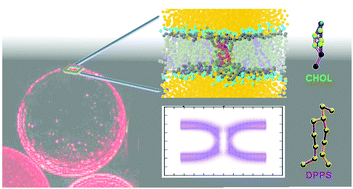Thermodynamics of cell-penetrating HIV1 TAT peptide insertion into PC/PS/CHOL model bilayers through transmembrane pores: the roles of cholesterol and anionic lipids†
Abstract
Efficient delivery of pharmaceutically active molecules across cellular membranes using cell penetrating peptides (CPPs), such as the cationic human immunodeficiency virus-1 trans-acting activator of transcription peptide (HIV-1 TAT), continues to attract scientific attention in drug design and disease treatment. Experimental results show that the TAT peptide is not only capable of directly penetrating the biological membrane in a passive manner, but also forming physical, membrane-spanning pores that may facilitate transport. Experiments further show that anionic lipids accelerate peptide permeation within a range of mole percentage composition. In this work, we explored the structures and translocation thermodynamics of the cationic TAT peptide across a series of DPPC/DPPS model membranes with the presence of 0–30 mol% cholesterol. We computed the potentials of the mean force by using umbrella sampling molecular dynamics simulations coupled to the Martini coarse-grained force field. We systematically investigated the roles of cholesterol and anionic lipids (membrane surface charge) in TAT peptide translocation. In qualitative agreement with experimental findings, the barrier heights were significantly reduced in the presence of anionic lipids. A toroidal hydrophilic pore was strongly suggested by membrane structure analysis. Cholesterol stabilizes the liquid-ordered (Lo) phase of membranes and increases the elastic stiffness of bilayers. Consequently, it hinders transmembrane pore formation and thus modulates solute permeability, since the liquid-ordered phase suppresses reorientation of the lipid molecules on simulation time scales. Though cholesterol contributes marginally to the total free energy associated with peptide permeation, the coordination of cholesterol to the peptide weakens more favorable peptide–lipid interactions. The addition of the anionic lipid DPPS to the neutral DPPC bilayer leads to the emergence and further enhancement of an interfacially stable state of the peptide due to the favorable peptide–anionic lipid interactions. Translocation free energy barriers decrease in lockstep with increasing DPPS composition in the model bilayers simulated. Finally, we investigated the size of hydrophilic pores emerging in our simulations, as well as the qualitative mobility of the peptide on the membrane surface.


 Please wait while we load your content...
Please wait while we load your content...